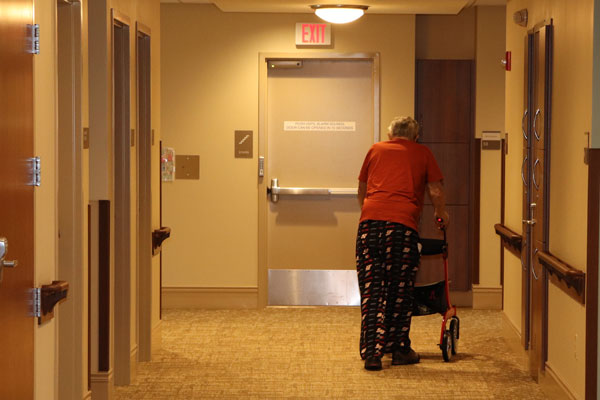Egress locks in patient care areas: What's OK?
 A resident uses a walker in a hallway of his long-term care center near an electronically controlled exit door with keypad and panic bar. CANCO photo
A resident uses a walker in a hallway of his long-term care center near an electronically controlled exit door with keypad and panic bar. CANCO photo
2 years, 10 months ago
By Ellen McCulley
Licensed Architect, Nelson Design, Inc.
Recently, we have been working on more memory care projects. The question always arises on what types of egress locks can be used and still allow the Owner and building to provide for fire and life safety for occupants, while balancing the need to prevent the elopement of clients or residents. Elopement refers to clients or residents leaving the building unsupervised. Fortunately, both the International Building Code (IBC) and NFPA Life Safety Code 101 have created provisions to lock the interior side of an egress door where the clinical needs of the person receiving care require their containment. The following article will specifically address the requirements in the IBC. The NFPA 101 requirements are very similar. As always, you should check with your Authority Having Jurisdiction (AHJ) as the requirements may vary by location.
Since 2015 the IBC has included a section entitled “Controlled egress doors in Groups I-1 and I-2”. (In the 2009 and 2012 versions it was called “Special locking arrangements in Group I-2.”) This section allows electric locking systems to be used in the means of egress where the clinical needs of those receiving care require their containment. The building must be equipped with an automatic sprinkler system or an approved automatic smoke or heat detection system. (Group I-1 and I-2 occupancies are required to contain an automatic sprinkler system by other provisions of the IBC). The following are requirements regarding the door installation and operation. Please refer to the code for a full description.
- The doors have to unlock upon the actuation of the automatic sprinkler system or automatic fire detection system.
- The door locks need to unlock upon power failure to the lock (fail safe).
- The door locking system shall have the ability to be unlocked by a switch located at the fire command center, nursing station, or other approved location.
- An occupant cannot be required to pass through more than one door with a controlled egress lock before entering an exit. Exit components can include exterior exit doors, interior exit stairways, exit passageways, horizontal exits, and exterior exit stairways.
- Door unlocking procedures needs to be included and approved as part of the emergency planning and preparedness required by Chapter 4 of the International Fire Code.
- All clinical staff shall have the keys/codes/means to operate the locking system.
- Emergency lighting needs to be provided at the doors.
- The door locking system units shall be listed in accordance with UL 294.
There are two exceptions to these rules that are worth noting in other project types.:
- Items one through four above do not apply where persons, because of clinical needs, require restraint or containment as part of a psychiatric treatment area.
- Items one through four above do not apply where a listed egress control system is utilized to reduce the risk of child abduction in nursery and obstetric areas of I-2 hospitals.
As always, if you have any questions regarding these code requirements or any others, please do not hesitate to contact me.

About the Author
Ellen McCulley graduated magna cum laude with a Bachelor of Architecture degree from Iowa State University, where she received the Pella Architectural Award from the Department of Architecture in the College of Design. She is a registered architect in Iowa, Illinois, Nebraska and Missouri, and joined Nelson Design, Inc., a wholly owned subsidiary of Carl A. Nelson & Company, in 2012.
How to obtain code review for your project or facility
Carl A. Nelson & Company is available to help clients address code-related issues in their facilities. Call (319) 754-8415 and ask for Ellen McCulley. Review past installments of Decoding the Code at www.carlanelsoncoconstruction.com/decoding-the-code/